Table of contents
- Make motorcycle equipment fit Check, maintain, repair
- leather
- Textile
- Jeans and Co.
- Functional underwear
- Helmets
- Protectors
- gloves
- Boots
- Dictionary

SYSTEM
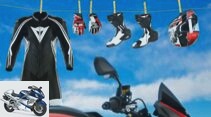

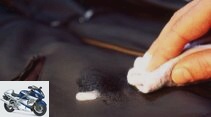
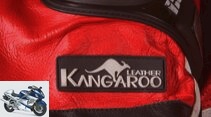
17th pictures
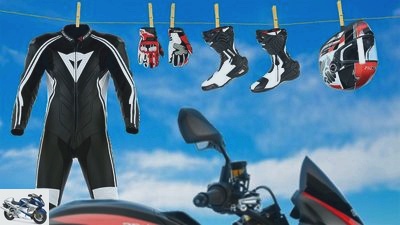
SYSTEM
1/17
Spring cleaning – properly care for your equipment.
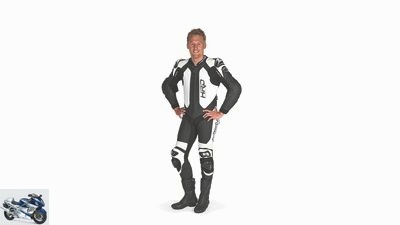
mps photo studio
2/17
Held Slade: test winner leather one-piece in MOTORRAD, issue 4/2016.
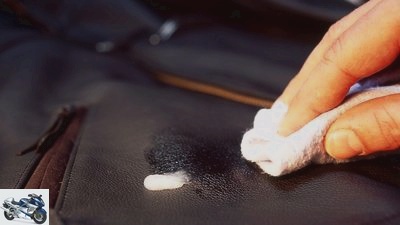
bilski-fotografie.de
3/17
After cleaning, the leather must be greased. Use leather oil for this.
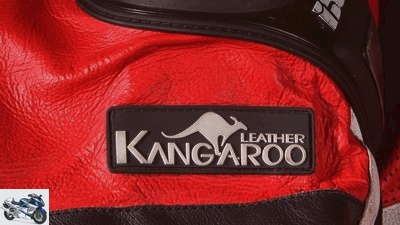
mps photo studio
4/17
Kangaroo leather is less sensitive to rain and, with the same thickness, more tear-resistant than cowhide, but it is also more expensive.
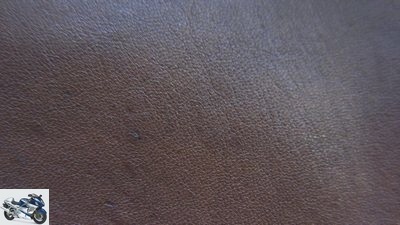
Yvonne Hertler
5/17
Cowhide is suitable for motorcycle clothing thanks to its low price and good abrasion quality.
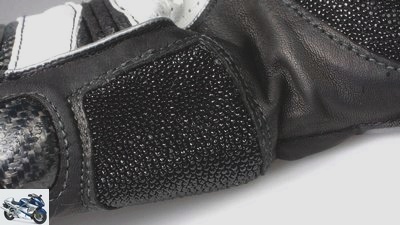
mps photo studio
6/17
Stingray leather is expensive and relatively inflexible, so it is only used in particularly stressed areas.
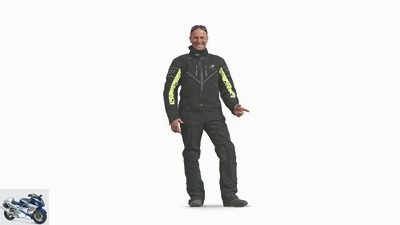
markus-jahn.com
7/17
Rukka Realer: Test winner textile suits in MOTORRAD, edition 19/2017.
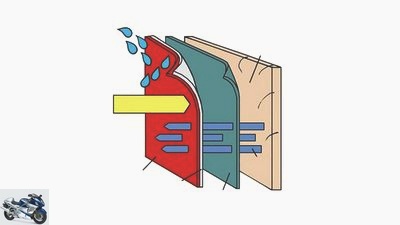
SYSTEM
8/17
Functional principle of a climate membrane: it is permeable to sweat in the form of water vapor, but it keeps rain off.
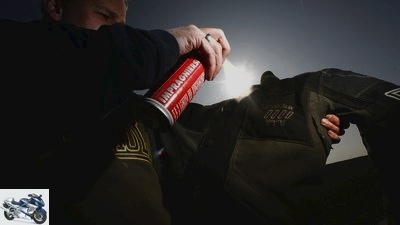
jkuenstle.de
9/17
Impregnation spray also helps, but refreshing the manufacturer’s impregnation is usually the better way.
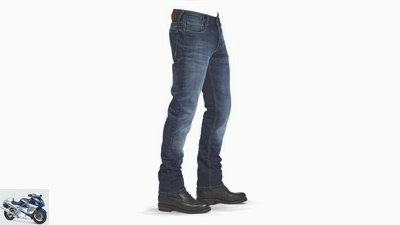
Rokker
10/17
Rokkertech Slim Stretch: Test winner retro combinations in MOTORRAD, edition 17/2017.
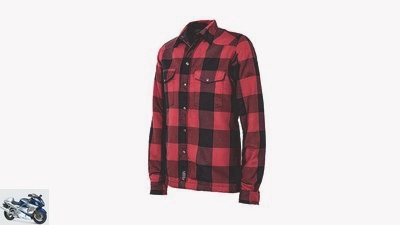
SYSTEM
11/17
John Doe Motoshirt: Offers protector pockets and combines cotton flannel with Kevlar lining.
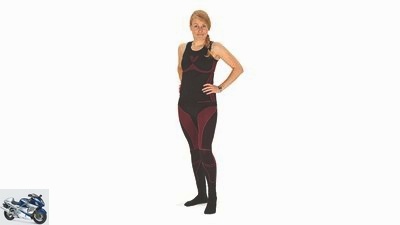
mps photo studio
12/17
Vanucci Seamless: Recommended summer functional clothing in MOTORRAD, edition 20/2017.
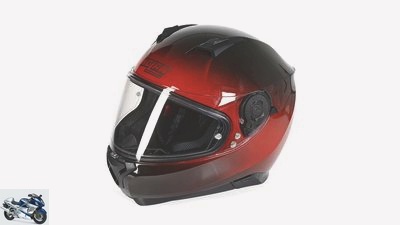
mps photo studio
13/17
Nolan N87: Test winner product test of mid-range full-face helmets in MOTORRAD 9/2017.
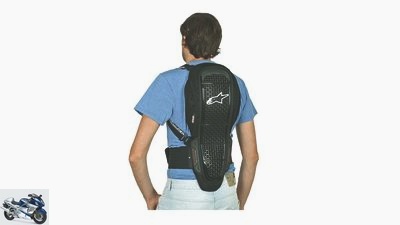
mps photo studio
14/17
Alpinestars Nucleon KR-1: Test winner back protectors in MOTORRAD, edition 17/2016.
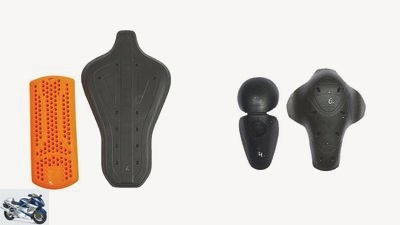
mps photo studio
15/17
Minimal versus optimal: Both joint and back protectors can differ significantly in size and fit.

Photo lab
16/17
Held Secret Dry: Test winner all-round gloves in MOTORRAD 14/2017.
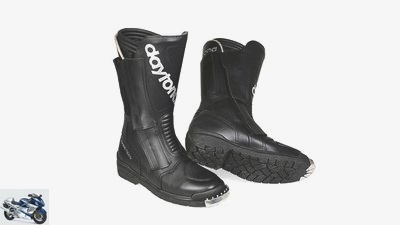
Photo lab
17/17
Daytona Trans Open GTX: Test winner adventure boots in MOTORRAD 8/2017.
clothing
Check, maintain and repair motorcycle equipment
Make motorcycle equipment fit
Check, maintain, repair
For many motorcyclists, the new season begins in March, and the motorcycle adventure beckons again. It’s good if the protective equipment is ready for it. We’ll show you tips and tricks on how to check your equipment from head to toe, care for it properly and repair it if necessary.
Tobias Beyl
03/27/2018
Who doesn’t know him, this weaker self. In late autumn, when everything seems to freeze in gray lethargy, many motorcyclists can barely pull themselves up to mothball their machine, but the protective clothing ekes out a rather dreary existence after the last ride. Littered with dead insects, covered with a thick layer of road dust and with sweat marks in the smelly food.
Buy complete article
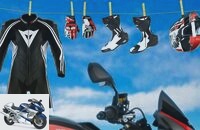
Make motorcycle equipment fit
Check, maintain, repair
7 pages) as PDF
€ 2.00
Buy now
Hopefully it’s not that bad for you, but high time to declare war on the bastard. Because the maintenance of the equipment is important, firstly, in order to be able to guarantee optimal protection, and secondly, it is not as complicated as you often think. Of course there are differences between leather and textile, between jeans and hard plastic. On the following pages we will show you how you are optimally equipped for your equipment and how you can best care for your equipment. You will also find tips for repairs if simple maintenance is not enough. And if it is time for something new for you, you will also find the MOTORRAD test winners in the respective category.
leather
The following still applies: when it comes to the best possible protection when falling on asphalt, leather has the edge over textile fibers. Because where there are large holes in the fabric, leather convinces with better abrasion quality. In terms of suitability for everyday use, however, you usually have to make compromises in leather suits, especially rain showers affect the material, especially with the frequently used cowhide. Kangaroo and stingray leather, which is only used in individual places, are less sensitive, but all types of leather require regular attention. After all, it is a natural product and even tanned, coated and varnished animal hides depend on intensive care.
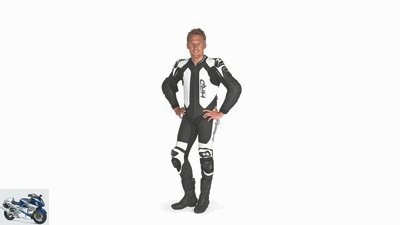
mps photo studio
Hero Slade.
Leather cleaning and care
At least once a year the leather gets really tough, but it is even better if you take care of a fresh finish after every ride in the rain and after stages on hot summer days.
1. Cleaning: Simply moisten leather clothing slightly, then the surface dirt can be removed fairly easily with a sponge or a soft brush. In order to wash off the real dirt, it is best to use special leather soaps, but alternatively a lye made from shower gel and / or neutral soap can also be used. With circular movements, dirt and grease can be removed particularly effectively from the structured leather surface. The loosened dirt is removed with a wet cloth. Special brushes that are available in drugstores or shoe stores are used for suede.
2. Drying: As with body care, cleaning is followed by drying, again preferably with a soft towel. Ideally, your leather suit dries at room temperature, under no circumstances should it hang over the heater or in the blazing sun.
3. Care: After cleaning, a special leather care oil is massaged into the slightly damp leather. Fat is not suitable for this, only use it before longer tours to better protect your station wagon from getting wet. In general, you should avoid all organic oils and fats, as these will go rancid and start to stink. Solvent-based and therefore strong grease-dissolving cleaners are also taboo.
Repair of leather
While maintenance is time-consuming but feasible, repairing leather is usually difficult.
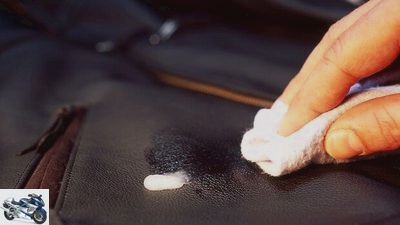
bilski-fotografie.de
After cleaning, the leather must be greased. Use leather oil for this.
Glued-on patches don’t last long, and when you try to sew the leather yourself, the sewing machine at home gives up. In addition, even visually small damage can only be repaired with relatively great effort, because the station wagon has to be partially dismantled. Therefore, going to a professional is usually the best way, leather specialists such as Alne or Schwabenleder offer professional repairs.
Textile
The practical motorcyclist no longer only wears tanned animal skins in the form of tight one- or two-piece suits, for many purposes synthetic textile suits have long stood out as the better choice because they are more suitable for everyday use.
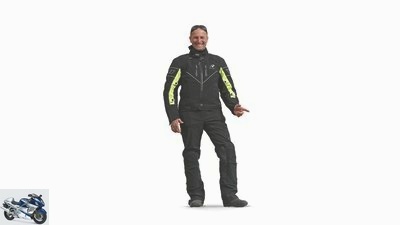
markus-jahn.com
Rukka Realer.
Leather may have better abrasion qualities than textile fabrics that melt when exposed to heat, but when it comes to active safety, textiles have the edge. Stretch inserts, ventilation zones, climate membranes – textile suits cut a good figure on both cold and wet days as well as on hot and sunny days. Another plus point: In contrast to leather, the polyamide fibers are not a natural product, so maintenance is far less complicated. Nevertheless, you should not neglect these with synthetic fiber suits either.
Care of textile fibers
First of all: the washing machine does not hurt the climate membrane! This frequent fear of motorcyclists about the protective film integrated in the textile suit is completely unfounded, only fabric softeners must not be used under any circumstances.

bilski-fotografie.de
Impregnation spray also helps, but refreshing the manufacturer’s impregnation is usually the better way.
Dirty or smelly clothing combinations can therefore end up in the washing machine with a clear conscience. There is now a colorful selection of differently expensive functional detergents, but a mundane mild detergent usually does the same. The usual information on the washing temperature can be found on the care label, an additional rinse washes away all residues. The protectors don’t belong in the washing machine, by the way. The foamed upholstery inserts in particular could become soaked with water, and in the long run the protective effect would also be gone. If the textile suit is only soiled on the surface, we recommend hand washing with plenty of water, neutral soap and a sponge or brush, as is the case with leather. When washing by hand, make sure to rinse with plenty of water, as detergent residues impair the function of the membrane. Then let it dry like normal laundry, in principle you can’t go wrong there either. A trick to freshen up the impregnation applied by the manufacturer: the care label reveals whether the suit can be ironed or thrown in the dryer. Ironing on a low setting or tumble drying for 20 minutes will bring back the famous beading effect. Commercial impregnators are only sprayed on if the original treatment is no longer sufficient.
Repair of the textile suit
Synthetic fiber fabric is easy to repair. Sewing works just as easily as with normal outerwear. It becomes more difficult if the climate membrane has a hole – or if the textile fabric has to be perforated when sewing. Absolute watertightness is then no longer guaranteed. In the long run, only going to the manufacturer helps. For a quick, but only temporary solution, the membrane can be re-sealed with special repair kits when you are out and about. Before installing the protectors, they can also be examined briefly: Are damaged parts such as cracked or porous surfaces visible? Put it away, you can usually get a new set of protectors from the manufacturer for a reasonable amount of money (50 to 70 euros).
Jeans and Co.
With the comfortable Buxe on the bike? So what, denim arrived on the motorcycle a long time ago, and the selection of biker jeans is now enormous.
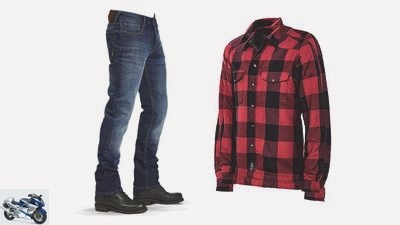
Rokker, SYSTEM
Rokkertech Slim Stretch, John Doe Motoshirt.
With these, aramid inserts reinforce the cotton fabric, or the fabric is woven directly in a single layer from so-called Ultra High Molecular Weight Polyethylene – in short: UHMWPE fibers with cotton sheaths. Both variants have advantages over the polyamide used in textile clothing in terms of heat resistance, because conventional plastic fibers melt at 200 ° C, and nobody wants to feel that on their skin. The cotton fabric, on the other hand, coagulates like burning paper, while the aramid fabric, also known as Kevlar depending on the manufacturer and equipped with a high level of abrasion resistance, protects the driver and his skin even after the actual denim has evaporated. And what about the care? Completely straightforward. As with textile suits, protectors should be removed beforehand, but then the clothes can simply be washed in the washing machine at home. When it comes to temperature, as always, pay attention to the information on the care label, but when it comes to repairs, the following applies: careful, no experiments! Tears or holes should only be sewn or stuffed with high quality thread.
Functional underwear
A few words about the underneath: Neither the favorite T-shirt in summer nor the knitted sweater in autumn and winter are suitable as underwear for the leather or textile combination.
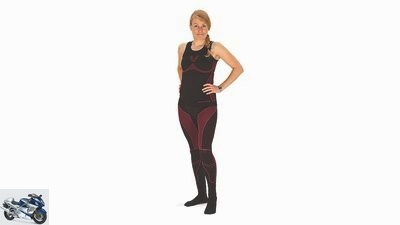
mps photo studio
Vanucci Seamless.
Not only does the fit of motorcycle clothing suffer, breathability is also inhibited – sweaty clothing is the result. Naturally, sweating cannot be avoided, as the body uses it to regulate its temperature. Precisely for this reason, only special functional fabrics should be worn directly on the skin, through which the sweat can evaporate and thus escape through the breathable climate membrane of the suit. Since the functional underwear still gets damp in summer, you should dry the underwear after every ride, which is usually very quick with the light functional materials. But what do you do if the functional underwear starts to smell? There is absolutely nothing wrong with washing functional clothing in the washing machine. Make sure, however, that you clean them separately from other textiles and that you do not use fabric softener. Both of these damage the fine gaps in the functional fabric. Normally, functional clothing is washed inside out, usually at 30 ° C on a gentle cycle and absolutely with liquid detergent or special functional detergent. An additional rinse then ensures that it is breathable after drying – pay attention to the instructions on the care label.
Should the function fail at any time, you will find special impregnating agents for functional underwear in stores. You can use it to refresh breathability and water impermeability.
Helmets
A hat that smells of sweat is the inevitable result if you don’t always wear a balaclava. Neither the washing machine nor the bathtub are then suitable for cleaning, because only the smell of sweat would be exchanged for the smell of mold.

mps photo studio
Nolan N87.
It is better to clean your helmet as follows: A sponge and water with washing-up liquid are suitable for the helmet shell, but this should not get into the ventilation slots. You should only clean the visor with gentle cleaners and soft cloths. Use soaked kitchen paper for soaking, very stubborn dirt can be sanded off with a nylon stocking. As a rule, even the cheapest helmet now has a removable pad: Put it in the helmet bag and wash it in the washing machine on a gentle cycle! Disinfecting helmet pad cleaners are a quick help during the season and when traveling.
Repair: Helmet repair? Definitely not after an accident! Because damage is usually not visible, but the protective function is over. Visors, on the other hand, are wearing items and can be changed easily and cheaply (approx. 20 euros).
Protectors
Basically, you should already pay attention to this when buying, but at the latest now when you are taking care of clothes care: Are protectors installed at all important points??
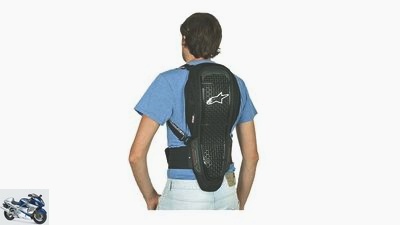
mps photo studio
Alpinestars Nucleon KR-1.
Padding on the back or hips is of little use, instead pay attention to special protectors that are also certified as such. You can recognize this by an imprint in the form of EN 1621-1: 2012 for joint protectors and EN 1621-2: 2012 for back protectors. But even the best protectors are of little use if they don’t fit properly. Pay attention to a body-hugging fit; The protector should enclose the joint well on the elbows, shoulders and knees. Because while leather, textile or denim protect against abrasion injuries, only well-fitting protectors are effective against broken bones.
If you notice damage to your protectors, you should completely replace the affected parts. Chest protectors are still quite rare, a current development are so-called motorcycle airbags (see MOTORRAD edition 4/2018).
gloves
People sweat, as is well known, also on the limbs. This includes not only the feet (see below), but also the hands.
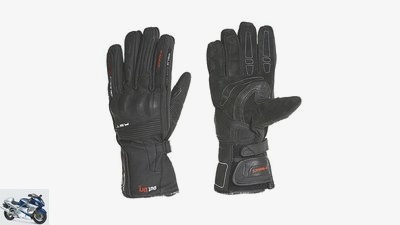
Photo lab
Hero Secret Dry.
Unlined leather gloves in particular suffer from the aggressive sweat of the skin. You should therefore clean them regularly, similar to a leather suit: wash the gloves in lukewarm water and with soap or a special leather cleaner, then rinse them several times. During the drying process in the air, put on the glove and form a fist, only after it has dried do you knead the leather glove until it is soft and treat it with leather oil.
In the case of textile gloves, the cleaning process can be shortened somewhat by only washing the lining material. Like textile suits, use a mild detergent and plenty of water. And like the leather counterparts, you can simply let your textile gloves air dry away from heating, sun and dryer.
Boots
Whether they stink or not, all motorcycle boots should be cleaned regularly. After all, they get sweat, splashed water, dirt and even oil splashes or chain grease.
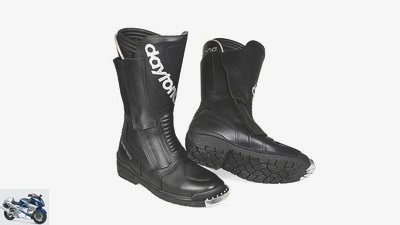
Photo lab
Daytona Trans Open GTX.
The best way to remove external dirt is with lukewarm water and a brush. Then, depending on the material, a leather care product or an impregnation is recommended, pay attention to the manufacturer’s instructions. You can usually remove the insole, shake it out and air it out without any problems. Avoid water inside the shoe, better shake or vacuum the inside. When drying, avoid direct heat lamps, but you can use special shoe dryers. With most sports boots, you can simply replace the grinders on the forefoot if they are worn off. You can obtain a replacement from specialist retailers. If, on the other hand, a membrane is damaged or the sole is worn, you only have to go to the specialist or, alternatively, to the manufacturer.
Dictionary
Aramid refers to a nylon synthetic fiber that is very tear, abrasion and heat resistant. It is often used for fabric reinforcement and is usually sold under brand names such as Kevlar.
Outer fabrics must be highly abrasion and tear resistant. In the motorcycle sector, various types of leather, textile fabrics and aramid reinforcements are possible.
Cordura is a brand name for yarn made from cut and spun polyamide fibers. Cordura fabric is very abrasion and wear-resistant, insensitive to dirt and windproof.
denier indicates the weight of textile fibers in grams per 9000 meters of thread length as a unit of measurement. 500 D to 1000 D are common in the motorcycle sector.
Fleece is a brushed polyester fabric that practically does not absorb moisture, is light and yet voluminous. This makes it suitable, for example, as a warming lining on the collar.
impregnation refers to the soaking treatment of a fabric, which makes it water-repellent.
Interior fabrics Above all, they should ensure comfort and insulation. They usually consist of polyester or polyamide.
Carbon / carbon fiber: The carbon fiber fabric is used to produce very hard and abrasion-resistant inserts that can be freely designed in terms of shape, similar to fiberglass made from glass fiber mats. It is used on helmet shells as well as in places where there is a risk of falls – especially on gloves and station wagons.
Climate membranes are either microporous (Gore-Tex) or coated films (e.g. Sympatex) that allow water vapor molecules to pass through (“breathable”), while water droplets roll off.
Neoprene refers to a waterproof synthetic rubber that is used as a kidney belt, neck and face protection.
Polyamide / polyester: Polyamide is a synthetic fiber that is very abrasion and tear resistant and only absorbs little water. It is usually used as an outer material. In comparison, polyester is heavier, absorbs even less water, but is also less tear-resistant. This makes it more suitable as a lining or membrane.
Scotchlite is a reflective material from the manufacturer 3M, which is used in logos and as a reflector on suits and gloves.
Related articles
-
Buying advice for alternative motorcycle rider equipment
mps studio 41 pictures Dentges 1/41 The gear lever often messes up street shoes. For 14.90 euros, Louis offers a “Shoe Protector”. Dentges 2/41 BW combat…
-
Repair motorcycle tires or not. What is allowed?
5 pictures 1/5 Annoying: screw in the tire and no more inflation pressure. Repairing is legally and technically possible. 2/5 Breakdown assistance…
-
Clean and maintain motorcycle chains
archive accesories Clean and maintain motorcycle chains Advice: chain maintenance How do I properly care for the chain on my motorcycle?? Your…
-
Sports & scene MOTORCYCLE COACH 2016 MOTORCYCLE COACH 2016 Drive safer, more confidently and better The MOTORRAD COACH 2016 has been available since May…
-
Bilski counselor workshop Check motorcycle Basic motorcycle check Brief routine before the trip You never have time for some annoyances – unless you take…
-
clothing Classic motorcycle equipment Classic motorcycle equipment Legend without end? Fackelmann station wagon, Elefantenboy, Pichler disguise: What…
-
BMW Connected Riders Gear: smart motorcycle equipment
BMW motorcycle 9 pictures BMW motorcycle 1/9 At first glance different from normal motorcycle clothing: BMW’s design for the safety clothing of the…
-
Product test: motorcycle jeans
Lohse 17th pictures Lohse 1/17 Of course, there is only one thing that can realistically test whether the jeans clothes really hold up: a fall. Since no…
-
Workshop gloves for screwing on the motorcycle
fact 22nd pictures mps photo studio 1/22 Ejendals Tegera 5117: Price: 10.90 euros. MOTORRAD verdict: very good. mps photo studio 2/22 Ellix 397627:…
-
Seven motorcycle leather one-pieces in the test
mps photo studio 26 pictures mps photo studio 1/26 Who has the choice … We tested seven upper middle class leather one-pieces. mps photo studio 2/26…